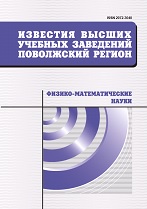|
|
University proceedings. Volga region. Physical and mathematical sciences, 2015, Issue 2, Pages 203–216
(Mi ivpnz300)
|
 |
|
|
Physics
Mathematical modeling of tuned thz polarizers based on the periodic 2D structures of rectangular graphene nanoribbons
G. S. Makeevaa, O. A. Golovanovb, V. V. Varenitsac, R. A. Gorelovb
a Penza State University, Penza
b Penza branch of the Military Academy of Maintenance Supplies, Penza
c Research and production association "Eshelon", Moscow
Abstract:
Background. Recent progress in the growth and patterning of graphene presents challenges and great opportunities for reconfigurable integrated plasmonic devices and metamaterials with potential applications for THz and IR polarizers and filters. The goal of the present work is the theoretical research of principals of creation of THz polarizers based on the periodic 2D structures of rectangular graphene nanoribbons, tuned by the external bias electric field, and their performances using rigorous mathematical modeling at electromagnetic accuracy level. Materials and methods. The rigorous mathematical model of graphene nanoribbon-based THz devices, based on solutions of the 3D diffraction boundary problems for the full set of Maxwell equations with electrodynamic boundary conditions, simultaneously with model of the graphene surface conductivity expressed from Kubo formula were developed using the Galerkin's projection method. Results. Using the computational algorithm based on the decomposition approach by autonomous blocks with graphene nanostructures and virtual Floquet channels (FABs), the scattering parameter |$S_{21}$| of THz polarizer, based on the periodic 2D structures of rectangular graphene nanoribbons on $SiO_2$ substrate, depending on the frequency and angle of incidence of TEM-wave for different values of the chemical potential was calculated at the frequency range 24-32 THz. Conclusions. The results of mathematical modeling show that upon changing the orientation of the electric field E of incident TEM-wave from parallel to normal to the nanoribbons the transmission coefficient |$S_{21}$| decreases, and in the stop band at the resonant THz frequency the periodic 2D structures of rectangular graphene nanoribbons can be considered as the THz polarizer. The S-parameters of the polarizers can be controlled by modifying the value of the chemical potential through changing the external bias electric field.
Keywords:
graphene, nanoribbons, Kubo formula, chemical potential, transmission coefficient, terahertz frequency range.
Citation:
G. S. Makeeva, O. A. Golovanov, V. V. Varenitsa, R. A. Gorelov, “Mathematical modeling of tuned thz polarizers based on the periodic 2D structures of rectangular graphene nanoribbons”, University proceedings. Volga region. Physical and mathematical sciences, 2015, no. 2, 203–216
Linking options:
https://www.mathnet.ru/eng/ivpnz300 https://www.mathnet.ru/eng/ivpnz/y2015/i2/p203
|

| Statistics & downloads: |
| Abstract page: | 37 | | Full-text PDF : | 22 | | References: | 19 |
|




 Contact us:
Contact us: Terms of Use
Terms of Use
 Registration to the website
Registration to the website Logotypes
Logotypes







 Citation in format
Citation in format 